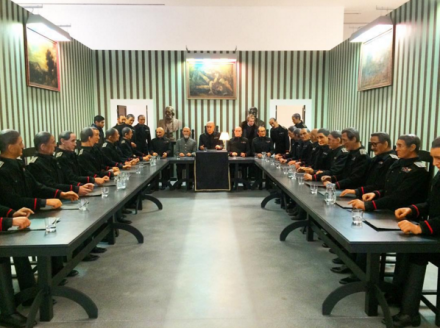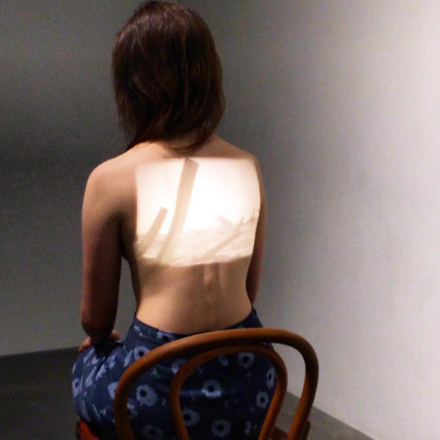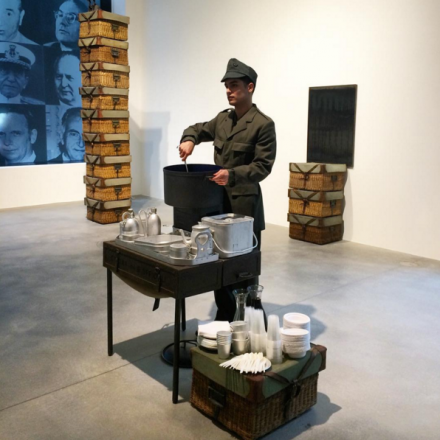
Fabio Mauri, Oscuramento (Darkening) (1975), all photos via Art Observed
Fabio Mauri’s work is defined by trauma. The Italian artist spent his early years growing up alongside the rise of the Italian Fascist Party. His childhood was defined by the images of war and violence, not merely through the scope of WWII, but in the violent political structures of the era that sent his family and countrymen to war. In his maturity, the late artist frequently returned to the sites and encounters with the images and iconography of that era in the Italian Nation, staging sculptural environments that placed domestic signifiers and human actors into contact with the objects of war: uniforms, helmets, weapons and scenes of twisted metal or military planning.

Fabio Mauri, Picnic o Il buon soldato (Picnic or The Good Soldier) (Installation View) (1998)
This darkly subdued body of work is the subject of an expansive exhibition at Hauser and Wirth’s Savile Row location in London, compiling a wide body of both sculptural and performative work from the course of his career that dwells on the human and the mechanic fusions that result from the movement towards all-encompassing war.
The exhibition is of particular note for its inclusion of some of Mauri’s most ambitious pieces, chief among them his installation Oscuramento – Il Gran Consiglio (Darkening – The Grand Council) (1975). This immense sculpture, featuring a series of military advisors seated around a series of long tables, recreates the final Grand Council of Fascism, in which the party finally decided upon the arrest of Mussolini, an action which ultimately triggered the temporary fragmentation of the Italian state, and which underscores the secretive, guarded decisions of vested power, accusing this small group of men in their roles ensuring the deaths of so many Italians.

Fabio Mauri, Picnic o Il buon soldato (Picnic or The Good Soldier) (Installation View) (1998)
Elsewhere, the gallery has installed Picnic o Il buon soldato (Picnic or The Good Soldier), an expansive series of pieces that instills the human element of war back into domestic scenarios. The solider’s personal belongings are placed alongside images of food and leisure, and underscored by the presence of a performer, dressed in historical military garb, and another female from his dreams serving attendees dinner. Nearby, a war-torn scene is projected onto the naked back of a woman, further driving at the disruption not only of human lives and bodies by war, but of their emotional landscapes more broadly.
![Fabio Mauri, Folgore (Picnic o Il buon soldato) [Lightning (Picnic or The Good Soldier)], (1998)](https://cdn.artobserved.com/artimages/2015/12/Fabio-Mauri-Folgore-Picnic-o-Il-buon-soldato-Lightning-Picnic-or-The-Good-Soldier-1998-440x440.png)
Fabio Mauri, Folgore (Picnic o Il buon soldato) [Lightning (Picnic or The Good Soldier)], (1998)
Through these actions, Mauri underscores the emotional weight and drawn-out processes of healing that follow the conclusion of war. His works here are unable to extract the violent past from their pleasant connotations; no matter how hard the soldier wishes to focus on the pleasantries of the picnic, or the love of a young woman, his memories are overshadowed by the symbols of death, of violence and destruction. The show offers a striking note in the context of 2015, as violence in Syria and stark ideological conflict continue to provoke international rumblings of war, reminding viewers of the great human toll this violence carries.
![Fabio Mauri, Nord Sud (Picnic o Il buon soldato) [North South (Picnic or The Good Soldier)] (1998)](https://cdn.artobserved.com/artimages/2015/12/Fabio-Mauri-Nord-Sud-Picnic-o-Il-buon-soldato-North-South-Picnic-or-The-Good-Soldier-1998-440x440.png)
Fabio Mauri, Nord Sud (Picnic o Il buon soldato) [North South (Picnic or The Good Soldier)] (1998)
— D. Creahan
Read more:
Fabio Mauri: Oscuramento. The Wars of Fabio Mauri [Hauser and Wirth]



